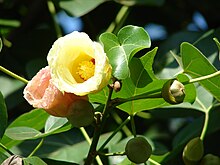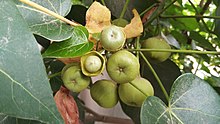Thespesia populnea
| Portia tree | |
|---|---|

| |

| |
| Scientific classification | |
| Kingdom: | Plantae |
| Clade: | Tracheophytes |
| Clade: | Angiosperms |
| Clade: | Eudicots |
| Clade: | Rosids |
| Order: | Malvales |
| Family: | Malvaceae |
| Genus: | Thespesia |
| Species: | T. populnea
|
| Binomial name | |
| Thespesia populnea | |
| Synonyms | |
| |
Thespesia populnea, commonly known as the portia tree (/ˈpɔːrʃə/),[4] Pacific rosewood,[5] Indian tulip tree, or milo,[6] among other names, is a species of flowering plant belonging to the mallow family, Malvaceae. It is a tree found commonly on coasts around the world.[7] Although it is confirmed to be native only to the Old World tropics, other authorities consider it to have a wider, possibly pantropical native distribution.[1] It is thought to be an invasive species in Florida and Brazil.[8][9]
Distribution
Thespesia populnea is native to tropical coastlines and is adapted for oceanic dispersal and growth in island environments. It is known from both coasts of Africa, tropical Asia, northern Australia, the Pacific Islands (including Hawaii), the tropical Pacific coast of the Americas from Mexico south to Colombia, the West Indies, and Florida in the United States. Its exact native distribution has been debated, with most authorities considering it to only be native to the Old World tropics,[10] some others such as Plants of the World Online including the Pacific Islands in its native range,[11][12] and others such as the IUCN Red List and the USDA also including the tropical Americas within its native range. The IUCN only considers T. populnea to be introduced and invasive in Florida.[1][13] It may also be invasive in northern Brazil.[9]
Like the related
Description

The Portia tree reaches a height of 6–10 m (20–33 ft) tall and its trunk can measure up to 20–30 cm (7.9–11.8 in) in diameter.[20] It grows at elevations from sea level to 275 m (902 ft)[21] in areas that receive 500–1,600 mm (20–63 in) of annual rainfall.[10] The Portia tree is able to grow in the wide range of soil types that may be present in coastal environments, including soils derived from quartz (sand), limestone, and basalt; it favours neutral soils (pH of 6–7.4).[20] Pollen grains are approximately 70 microns in diameter.
Uses
The
Portia tree is known as milo or miro in Polynesian languages.
In New Ireland, Portia wood is used to make hourglass drums. In Tonga, its bark is used to treat mouth infections among infants, and its wood is used to make canoes, house parts, and artwork.[25]
In Indonesia they are known as baru laut, baru pantai or waru lot. The Ambonese cook the leaves into a dish with vegetables.[26]
In South Asia, it is used to make the thavil, a Carnatic musical instrument of South India. The flower of the Portia tree played a part in Sri Lanka's independence movement, when it was sold on Remembrance Day by the Suriya-Mal Movement instead of the poppy to aid Sri Lankan ex-servicemen. The wood from the tree was used by early Tamil people to make instruments in ancient Tamilakam.[27] It can be used for the cellulose production from the plants [Singh et al. 2019].
In some parts of the world, such as
See also
References
- ^ . Retrieved 27 June 2022.
- ^ "Thespesia populnea". Germplasm Resources Information Network. Agricultural Research Service, United States Department of Agriculture. Retrieved 17 November 2009.
- ^ Thespesia populnea (L.) Sol. ex Corrêa — The Plant List
- ISBN 978-1870836111.)
In S. India the common name of the Thespesia populnea, Lam. (N.O. Malvaceae), a favourite ornamental tree, thriving best near the sea. The word is a corruption of Tamil Puarassu, 'Flower-king; [puvarasu, from pu, 'flower,' arasu, 'peepul tree'].
{{cite encyclopedia}}: CS1 maint: location missing publisher (link) CS1 maint: multiple names: authors list (link - ^ USDA, NRCS (n.d.). "Thespesia populnea". The PLANTS Database (plants.usda.gov). Greensboro, North Carolina: National Plant Data Team. Retrieved 9 December 2015.
- ^ a b "Milo". Te Māra Reo: The Language Garden. Benton Family Trust. 2023. Retrieved 17 June 2023.
- ^ Oudhia, P., 2007. Thespesia populnea (L.) Sol. ex Corrêa. [Internet] Record from PROTA4U. Louppe, D., Oteng-Amoako, A.A. & Brink, M. (Editors). PROTA (Plant Resources of Tropical Africa / Ressources végétales de l’Afrique tropicale), Wageningen, Netherlands.
- ^ "Thespesia populnea - Species Details". Atlas of Florida Plants. Retrieved 27 June 2022.
- ^ ISSN 2236-3777.
- ^ a b c Francis, John K. (1 January 2003). "Thespesia populnea (L.) Sol. ex Corrêa". Tropical Tree Seed Manual. Reforestation, Nurseries & Genetics Resources. Archived from the original (PDF) on 16 January 2009. Retrieved 20 February 2009.
- ^ a b "Thespesia populnea (L.) Sol. ex Corrêa | Plants of the World Online | Kew Science". Plants of the World Online. Retrieved 27 June 2022.
- ^ a b "Native Plants Hawaii - Viewing Plant : Thespesia populnea". nativeplants.hawaii.edu. Retrieved 27 June 2022.
- ^ "Thespesia populnea (portia tree)". www.cabi.org. Retrieved 27 June 2022.
- ^ ISBN 9781922144256.
- ^ .
- ^ "Bishop Museum - Ethnobotany Database". data.bishopmuseum.org. Retrieved 27 June 2022.
- ^ .
- S2CID 85841084.
- ^ ISSN 0030-8870.
- ^ a b Friday, J. B.; Okano, Dana (April 2006). "Thespesia populnea (milo)" (PDF). The Traditional Tree Initiative. Retrieved 20 February 2009.
- Bernice P. Bishop Museum. Retrieved 24 November 2020.
- S2CID 89149453.
- .
- ^ Brooke, M. de L.; I. Hepburn; R.J. Trevelyan (2004). "Henderson Island World Heritage Site Management Plan 2004–2009" (PDF). Foreign and Commonwealth Office, London. p. 19. Archived from the original (PDF) on 19 July 2007. Retrieved 31 March 2009.
- ^ Pawley, Andrew; Osmond, Meredith (eds). 2008. The lexicon of Proto Oceanic: The culture and environment of ancestral Oceanic society. Volume 3: Plants. Pacific Linguistics 599. Canberra: Pacific Linguistics, Australian National University.
- ^ Heyne, Karel (1913). "Thespesia populnea". De nuttige planten van Nederlandsch-Indië (in Dutch). Bogor: Museum vor Economische Botanie & Ruygrok. pp. 207–8.
- ^ (Source: OED)
- ISSN 2344-3219.
Further reading
- "Thespesia populnea". Australian Native Hibiscus and Hibiscus-like Species.
External links
- "Milo". Canoe Plants of Ancient Hawaiʻi. Ka ʻImi Naʻauao O Hawaiʻi Nei.
- "Thespesia populnea (L.) Sol. Ex Corr". Database of Indian Plants. Pandanus Project.
- Images on Wikipedia commons

